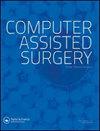用于前列腺MR图像分割的密集扩张空间金字塔池编码器-解码器
IF 1.9
4区 医学
Q3 SURGERY
引用次数: 10
摘要
前列腺磁共振图像的自动分割对前列腺疾病的诊断和临床应用具有重要意义。由于组织边界的低对比度和前列腺MR图像的小有效面积,它面临着巨大的挑战。为了解决这些问题,我们提出了一种新的端到端专业网络,该网络由具有密集扩张空间金字塔池(DDSPP)的编码器-解码器结构组成,用于基于深度学习的前列腺分割。首先,使用DDSPP模块提取前列腺MR图像中的多尺度卷积特征,然后使用解码器捕获前列腺的清晰边界。在130张MR图像上产生了与现有技术相比具有竞争力的结果,这些图像的关键度量Dice相似性系数(DSC)和Hausdorff距离(HD)分别为0.954和1.752 mm。实验结果表明,该方法具有较高的精度和鲁棒性。本文章由计算机程序翻译,如有差异,请以英文原文为准。
Encoder-decoder with dense dilated spatial pyramid pooling for prostate MR images segmentation
Abstract Automatic segmentation of prostate magnetic resonance (MR) images has great significance for the diagnosis and clinical application of prostate diseases. It faces enormous challenges because of the low contrast of the tissue boundary and the small effective area of the prostate MR images. In order to solve these problems, we propose a novel end-to-end professional network which consists of an Encoder-Decoder structure with dense dilated spatial pyramid pooling (DDSPP) for prostate segmentation based on deep learning. First, the DDSPP module is used to extract the multi-scale convolution features in the prostate MR images, and then the decoder is used to capture the clear boundary of prostate. Competitive results are produced over state of the art on 130 MR images which key metrics Dice similarity coefficient (DSC) and Hausdorff distance (HD) are 0.954 and 1.752 mm respectively. Experimental results show that our method has high accuracy and robustness.
求助全文
通过发布文献求助,成功后即可免费获取论文全文。
去求助
来源期刊

Computer Assisted Surgery
Medicine-Surgery
CiteScore
2.30
自引率
0.00%
发文量
13
审稿时长
10 weeks
期刊介绍:
omputer Assisted Surgery aims to improve patient care by advancing the utilization of computers during treatment; to evaluate the benefits and risks associated with the integration of advanced digital technologies into surgical practice; to disseminate clinical and basic research relevant to stereotactic surgery, minimal access surgery, endoscopy, and surgical robotics; to encourage interdisciplinary collaboration between engineers and physicians in developing new concepts and applications; to educate clinicians about the principles and techniques of computer assisted surgery and therapeutics; and to serve the international scientific community as a medium for the transfer of new information relating to theory, research, and practice in biomedical imaging and the surgical specialties.
The scope of Computer Assisted Surgery encompasses all fields within surgery, as well as biomedical imaging and instrumentation, and digital technology employed as an adjunct to imaging in diagnosis, therapeutics, and surgery. Topics featured include frameless as well as conventional stereotactic procedures, surgery guided by intraoperative ultrasound or magnetic resonance imaging, image guided focused irradiation, robotic surgery, and any therapeutic interventions performed with the use of digital imaging technology.
 求助内容:
求助内容: 应助结果提醒方式:
应助结果提醒方式:


